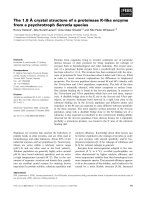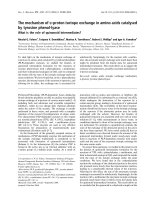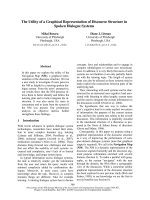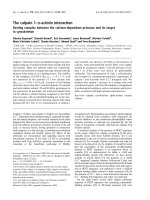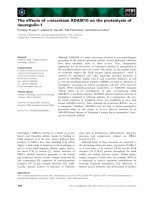Báo cáo khoa học: "The "Win-Win" initiative: a global, scientifically based approach to resource sparing treatment for systemic breast cancer therapy" pdf
Bạn đang xem bản rút gọn của tài liệu. Xem và tải ngay bản đầy đủ của tài liệu tại đây (201.02 KB, 5 trang )
BioMed Central
Page 1 of 5
(page number not for citation purposes)
World Journal of Surgical Oncology
Open Access
Correspondence
The "Win-Win" initiative: a global, scientifically based approach to
resource sparing treatment for systemic breast cancer therapy
Ahmed Elzawawy
1,2,3,4,5
Address:
1
Clinical Oncology Department, Faculty of Medicine, Suez Canal University, Egypt,
2
Alsoliman Radiation Oncology Unit, Port Said,
Egypt,
3
Early Detection and Cancer Chemotherapy Unit, Port Said General Hospital, Egypt,
4
ICEDOC: International Campaign for Establishment
and Development of Oncology Centers & ICEDOC's Experts in Cancer without Borders, USA and
5
SEMCO: South and East Mediterranean college
of Oncology, Egypt
Email: Ahmed Elzawawy -
Abstract
Background: Worldwide, breast cancer is the most frequent malignancy among females. Its
incidence shows a trend towards an increase in the next decade, particularly in developing
countries where less than of 5% of resources for cancer management are available. In most breast
cancer cases systemic cancer treatment remains a primary management strategy. With the
increasing costs of novel drugs, amidst the growing breast cancer rate, it can be safely assumed that
in the next decade, newly developed cancer drugs will become less affordable and therefore will be
available to fewer patients in low and middle income countries. In light of this potentially tragic
situation, a pressing need emerges for science-based innovative solutions.
Methods: In this article, we cite examples of recently published researches and case management
approaches that have been shown to lower overall treatment costs without compromising patient
outcomes. The cited approaches are not presented as wholly inclusive or definitive solutions but
are offered as effective examples that we hope will inspire the development of additional evidence-
based management approaches that provide both efficient and effective breast cancer treatment
Results: We propose a "win-win" initiative, borne in the year of 2008 of strategic information
sharing through preparatory communications, publications and our conference presentations. In
the year 2009, ideas developed through these mechanisms can be refined through focused small
pilot meetings with interested stakeholders, including the clinical, patient advocate, and
pharmaceutical communities, and as appropriate (as proposed plans emerge), governmental
representatives. The objective is to draw a realistic road map for feasible and innovative scientific
strategies and collaborative actions that could lead to resource sparing; i.e. cost effective and
tailored breast cancer systemic treatment for low and middle income countries.
Conclusion: The intended result would assure sustained affordability and accessibility in breast
cancer systemic therapy for patients in low and middle income countries. As an added benefit, the
example of breast cancer could be expanded to include other cancers in diverse settings around
the world.
Published: 5 May 2009
World Journal of Surgical Oncology 2009, 7:44 doi:10.1186/1477-7819-7-44
Received: 23 May 2008
Accepted: 5 May 2009
This article is available from: />© 2009 Elzawawy; licensee BioMed Central Ltd.
This is an Open Access article distributed under the terms of the Creative Commons Attribution License ( />),
which permits unrestricted use, distribution, and reproduction in any medium, provided the original work is properly cited.
World Journal of Surgical Oncology 2009, 7:44 />Page 2 of 5
(page number not for citation purposes)
Background
By the year 2020, 70% of the twenty million new cancer
cases will occur in countries that collectively have only
five percent of the global resources for cancer control [1].
Breast cancer is the most frequent cancer among females.
Globally the incidence of breast cancer is increasing, and
the rate of increase is highest in developing countries. [2].
This trend provides every indication that the need for sys-
temic anticancer agents will continue to increase over the
next ten years. The pharmaceutical companies are devel-
oping increasingly expensive novel anticancer molecules
with no indication that the rapidly escalating cost of new
treatments will ease in future. Improvements in the over-
all and disease-free survival rates and quality of life are not
commensurate with the soaring costs of cancer treatment.
The major markets for the leading pharmaceutical indus-
try are in the United States, Western Europe and Japan;
and while these regions may be able to meet the increased
cost of treatment, it can be safely assumed that the cost of
novel anticancer drugs will continue to expand as an
insurmountable obstacle to care for an ever greater pro-
portion of cancer patients in Low and Middle Income
Countries (LMCs) where the majority of the world's pop-
ulation live. This discomforting reality confronts us with
difficult challenges that merit the spirited engagement of
regional and international health leaders.
Breast Cancer, with its predictable increase in incidence,
and multiple available, effective treatment options pro-
vides an excellent starting point for developing economi-
cally sustainable cancer control strategies that could be
tailored in LMCs for other forms of cancer as well.
Aims and hopes
It is our aim to establish a scientific initiative to expand
availability of resource sparing Breast Cancer Systemic
Therapy (BCST) and hope that such strategy may meet the
demand for effective, affordable breast cancer care for
patients who would otherwise be left without scientifi-
cally valid treatment options.
Methods
This communication reviews examples of recent and
ongoing scientific researches and suggestions that could
lead to lower costs of BCST without compromising overall
patient outcomes. These findings, this summary, and sub-
sequent detailed publications, and conference presenta-
tions can provide a basis for pilot meetings to launch a
"win-win" scientific initiative based on cooperation and
collaboration of stakeholders; whereby markets are cre-
ated or maintained for effective cancer therapies, and
patients are assured access to these interventions regard-
less of where in the world they reside.
Results
A) Relatively recent drugs
The duration of the course trastuzumab (Herceptin
®
)
A trial of 9-weeks of trastuzumab treatment has been com-
pared to 52 weeks treatment. Both arms were similar in
outcome [3]. We assume that these preliminary results
need to be confirmed in a larger sample. In addition to the
cost savings from the shortened treatment interval with
trastuzumab, we could expect further reduction in costs
due to fewer hospitalizations and less need for supportive
treatment.
Evidence based cost effective prescription of drugs
Limiting use of trastuzumab (Herceptin
®
) to women with
localized disease and known HER2/neu-positive status, as
suggested by Yarney and colleagues[4] is a cost-effective
use if resources are available, even with the additional
costs of HER2/new testing.
Low dose, prolonged infusion gemcitabine
The encouraging response of phase I-II trials of low dose
gemcitabine in prolonged infusion in the treatment of cer-
tain solid cancers, e.g. non small cell lung cancer, breast,
pancreas and bladder cancers deserves further investiga-
tion. The explanation for these responses caused by low
doses (of 250 mg and 180 mg/m
2
for 6, 24 hours respec-
tively) lies in the saturation of deoxcytidine kinase which
occurs after short infusion at conventional doses. This
enzyme is needed for conversion of gemcitabine into its
active form gemcitabine triphosphate. While short usual
infusion leaves most of the drug unmetabolized, pro-
longed infusion apparently leads to a higher intracellular
concentration of the active metabolite [5]. More studies
are needed in different clinical settings to verify the effec-
tiveness and cost implications of extended (six hours infu-
sion), using reduced drug dosages.
The Glivec
®
International Patient Assistance Program (GIPAP)
is a worldwide program to provide imatinib (Glivec
®
) at
no cost to patients with chronic myelogenous leukemia
(CML) or gastrointestinal stromal tumor (GIST) in 81
countries who would not otherwise have access to com-
prehensive reimbursement for the treatment[6]. This
example could be explored for other drugs with other par-
ties.
Interrupted courses of treatment
Aromatase inhibitors (AI), when given as interrupted
course, probably would also be effective as continuous
therapy after prior tamoxifen and/or AI treatment. The
hypothesis is that AI interrupted courses may cause estro-
genic stimulation and enhance response of residual resist-
ant cells[7]. We cite this example not for application as a
finally proven scientific and economically sound
approach, but as an example of the possibilities for inter-
World Journal of Surgical Oncology 2009, 7:44 />Page 3 of 5
(page number not for citation purposes)
rupting the continuity of a treatment course without com-
promising the result. The principle implied by this
intriguing example merits further study.
Pharmacokintetic based studies in lapatinib therapy
According to recent studies, it is shown that lapatinib
when taken orally with food -not on an empty stomach as
cited frequently–yields an increased plasma level. Lower
oral doses administrated with food and with grapefruit
juice could effectively inhibit the enzyme CYP3A and
thereby could provide comparable effect. Up to 80% of
the dose and the cost of the drug could be reduced by this
approach [8]. More studies are needed in this field.
- There are greater possibilities in using oral cancer
drugs [9]. The oral route for cancer therapy may decrease
costs due to fewer hospital inpatient admissions and out-
patient chemotherapy intravenous sessions. Obviously,
this approach requires careful study in diverse communi-
ties. Questions of cost-effectiveness and best practices
relating to oral and self-administered agents are of consid-
erable interest in LMCs where facilities and providers may
be particularly scarce.
B) Essential and conventional systemic cancer drugs
The following concise points relate to what some refer to
as "the essential and conventional" systemic cancer drugs:
Fortunately, the pharmaceutical arsenal of "essential and
conventional systemic anticancer drugs" still constitutes
the basis of this treatment modality. In addition, these
conventional drugs are relatively inexpensive. For breast
cancer the list would include CMF (Cyclophosphamide,
Methotrexate and 5 Fluorouracil), FAC (5 Fluorouracil,
Doxorubicin and Cyclophosphamide), Tamoxifen and
Ovarian ablation.
Innovative strategic thinking and approaches should be
encouraged to improve the availability and accessibility of
first-line systemic anticancer treatments as part of the
comprehensive breast cancer control plan for underserved
countries. An example of novel chronology and mode of
drug administration that tests additional mechanisms of
actions and indications is the metronomic use of pro-
longed, low oral doses of cyclophosphamide and meth-
otrexate as palliative breast cancer treatment [10]. While
an example of new applications for relatively old and less
expensive drug is the use of Cisplatin in triple negative
breast cancer patients [11].
Generic equivalents for off-patent drugs
offer the possibility of less expensive treatment. However,
the quality and bioequivalence of generics used in devel-
oping countries should be assured by regulations or devel-
oping a transparent system for international testing. To
overcome difficulties in achieving large scale feasibility in
quality control, we suggest working at the small scale level
to test random samples or pilot settings upon invitation
from the local authorities in some developing countries.
Pharmcogenomic studies
Tamoxifen requires enzymatic activation by CYP 450
enzymes for the formation of clinically relevant metabo-
lites 4-OH-tamoxifen and endoxifen which both have a
greater affinity to the estrogen receptors and ability to
inhibit cell proliferation when compared to the parent
drug. The key enzyme in this bio-transformation is the
CYP2D6. Recent pharmacological and clinical pharmaco-
genetics evidence suggests that genetic variants and drug
interaction by CYP2D6 inhibitors influence plasma con-
centration of active tamoxifen metabolites and thereby
improve treatment outcome of breast cancer patients
treated by adjuvant tamoxifen [12]. It is speculated that
the benefit of 5 years of adjuvant tamoxifen may even
exceed that achieved through "upfront" AI treatment in
postmenopausal CYP2D6 wt/wt genotype patients.
Despite its expenses and technological requirements, we
assume that, CYP2D6 genotyping prior to treatment could
open new avenues for individualization of endocrine
treatment. Hence, unnecessary treatment and costs
extending over years could be avoided. However, we stress
the need for wider studies to test cost effectiveness in dif-
ferent communities and the feasibility of technology
transfer via international scientific cooperation.
Another approach would be to help develop the required
infrastructure for the clinical research and trials with prag-
matic goals that would be ideally suited to LMCs, few sug-
gestions for this are:
For older drugs
a) To tailor treatment to patients, community and tumor
factors (based on clinical, pathological and biological fac-
tors).
b) To address economic considerations, cost-effectiveness
and quality of life issues within each community or
region.
c) To test innovative combinations or different schedules
of administration of older (and relatively cheaper) drugs
that might lead to previously improved therapeutic index
or applicability to specific societies. Such investigations
usually are not supported by pharmaceuticals companies
and international conferences, although they might be of
benefit to science and cancer patients in LMCs.
d) To test new uses of a relatively old and less expensive
drugs (as earlier cited in the use of Cisplatin in triple neg-
ative breast cancer patients).
World Journal of Surgical Oncology 2009, 7:44 />Page 4 of 5
(page number not for citation purposes)
For novel drugs
e) Conducted with appropriate ethical guidelines and
international oversight, clinical research would provide
broader and more transparent access to novel drugs, and
would enhance professional education and training in
LMCs. Such an approach would assist companies in
streamlining the development of new drugs.
Future directions and conclusion
On behalf of ICEDOC's Experts in Cancer without borders
(ICEDOC is The International Campaign for Establish-
ment and Development of Oncology Centers http://
www.icedoc.org), we propose "The win-win initiative". It
starts with communications and publications. Then, we
propose to hold small pilot working meetings with repre-
sentatives of interested parties and willing leading phar-
maceutical companies. Next, we would look to larger
meetings and collaborative actions with a broader range
of participants.
The goals of this approach include:
• To create a Think Tank or what Franklin Roosevelt
described as "A Brain Trust", opened for innovative
scientific thoughts and ideas that could lead to cost -
effective systemic treatment for more breast cancer
patients in LMCS.
• To develop a strategy to coordinate ongoing efforts
and initiatives.
• To recommend areas of innovative clinical research
that address the needs of LMCs
• To identify key components and infrastructure needs
in LMCs to support research
• To determine the key barriers to pharmaceutical
companies in investing in LMCs research and provide
a strategy to overcome those barriers.
-Investment in creating infrastructure will create
new markets
-Old drugs can bring new profits and its use may
pave ways for novel drugs.
The outcome of the communications and meeting for the
year 2009 would be a road map for the win-win initiative
• An actionable strategy opened for contribution, col-
laboration and coordinating efforts and ideas.
• Formation of a collaborative task force group that
aims at more availability and affordability of systemic
cancer therapy in LMCs.
• A published report on recommended research and
key components.
• A proposal of pilot projects.
Finally, no leadership role, or claim to invention is being
made. There are many key players and stakeholders in the
world. Coordination and cooperation are needed.
Competing interests
The author declares that they have no competing interests.
Acknowledgements
I thank Dr. Pamela Haylock, Secretary General of ICEDOC, Texas, USA
and Mr. Dan Rutz, (ICEDOC), Sr.Communications Specialist, National
Center for Health Marketing (NCHM), Centers for Disease Control and
Prevention (CDC), Atlanta, Georgia, USA and former senior medical cor-
respondent of CNN, USA for their valuable advice in editing the text. Also,
I present special thanks to Dr. Hossam Elbahaie, (ICEDOC), Port Said,
Egypt, for his assistance in preparing the manuscript.
References
1. Sikora K: Developing a global strategy for cancer. Eur J Cancer
1999, 35:1870-1877.
2. Stewart BW, Kleihues P: World cancer report. Lyon, France,
IARC Press; 2003.
3. Joensuu H, Kellokumpu-Lehtinen PL, Bono P, Alanko T, Kataja V,
Asola R, Utriainen T, Kokko R, Hemminki A, Tarkkanen M, Turpeen-
niemi-Hujanen T, Jyrkkio S, Flander M, Helle L, Ingalsuo S, Johansson
K, Jaaskelainen AS, Pajunen M, Rauhala M, Kaleva-Kerola J, Salminen
T, Leinonen M, Elomaa I, Isola J: Adjuvant docetaxel or vinorel-
bine with or without trastuzumab for breast cancer. N Engl J
Med 2006, 354:809-820.
4. Yarney J, Vanderpuye V, Clegg Lamptey JN: Hormone receptor
and herHER-2 expression in breast cancers among subSub-
sSaharan african African women. Breast J 2008, 14:510-511.
5. Zwitter M, Kovac V, Smrdel U, Kocijancic I, Segedin B, Vrankar M:
Phase i-ii trial of low-dose gemcitabine in prolonged infusion
and cisplatin for advanced non-small cell lung cancer. Antican-
cer Drugs 2005, 16:1129-1134.
6. Lassarat S, Jootar S: Ongoing challenges of a global interna-
tional patient assistance program. Ann Oncol 2006, 17(Suppl
8):viii43-viii46.
7. Colleoni M, Maibach R: BIG 1-07/IBCSG 35-07 SOLE. Ready for
activation. Breast international group newsletter 2007, 9:22.
8. Ratain MJ, Cohen EE: The value meal: How to save $1,700 per
month or more on lapatinib. J Clin Oncol 2007, 25:3397-3398.
9. Puozzo C, Gridelli C, Jaworski M: Pharmacokinetics of navelbine
oral in elderly patients. Tumori 2002, 88:S75-S76.
10. Colleoni M, Rocca A, Sandri MT, Zorzino L, Masci G, Nole F, Peruz-
zotti G, Robertson C, Orlando L, Cinieri S, de BF, Viale G, Goldhirsch
A: Low-dose oral methotrexate and cyclophosphamide in
metastatic breast cancer: Antitumor activity and correla-
tion with vascular endothelial growth factor levels. Ann Oncol
2002, 13:73-80.
11. Garber JE, Richardson A, Harris LN, Miron A, Silver D, Golshan M:
New adjuvant cisplatin (cddp) in "Triple-negative" Breast
cancer (bc). San Antonio Breast Cancer Synposium 2006. Abstract
3074
12. Goetz MP, Knox SK, Suman VJ, Rae JM, Safgren SL, Ames MM, Viss-
cher DW, Reynolds C, Couch FJ, Lingle WL, Weinshilboum RM,
Fritcher EG, Nibbe AM, Desta Z, Nguyen A, Flockhart DA, Perez EA,
Ingle JN: The impact of cytochrome p450 2d6 metabolism in
World Journal of Surgical Oncology 2009, 7:44 />Page 5 of 5
(page number not for citation purposes)
women receiving adjuvant tamoxifen. Breast Cancer Res Treat
2007, 101:113-121.
